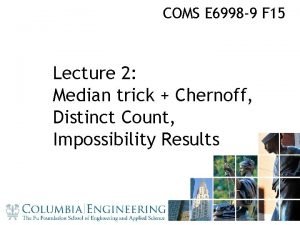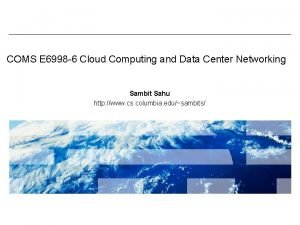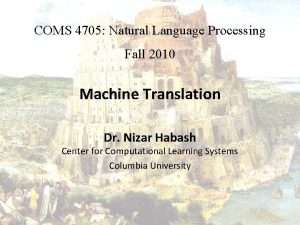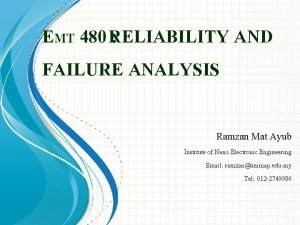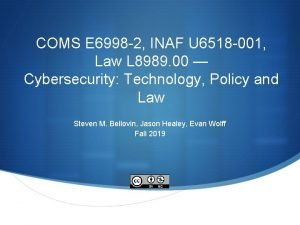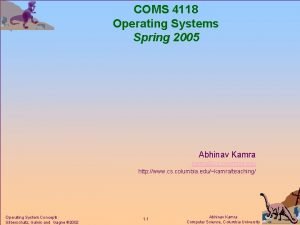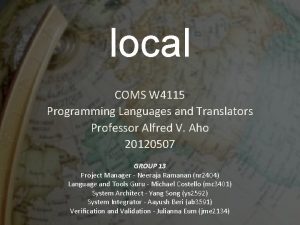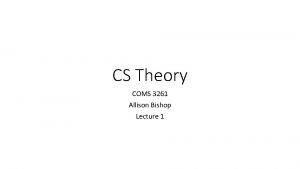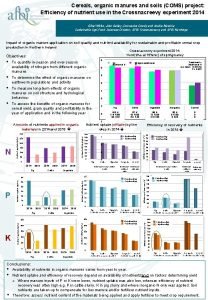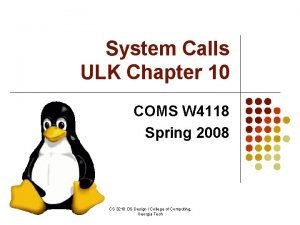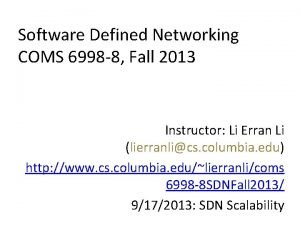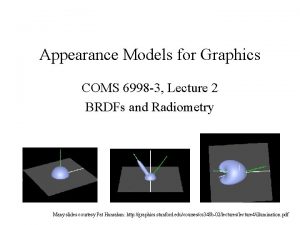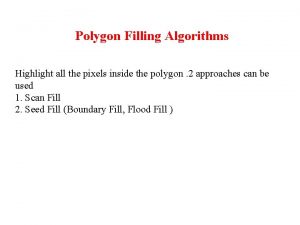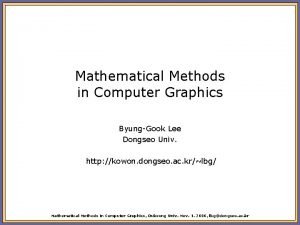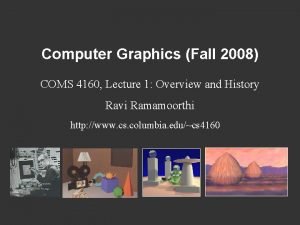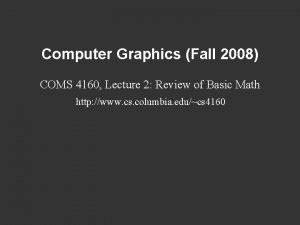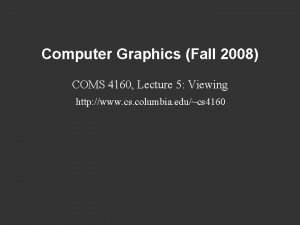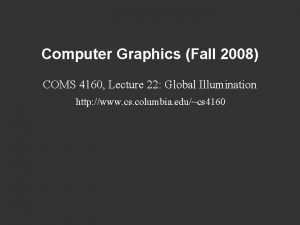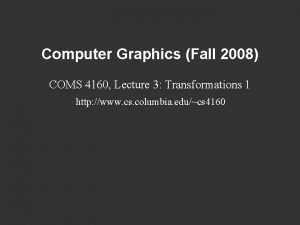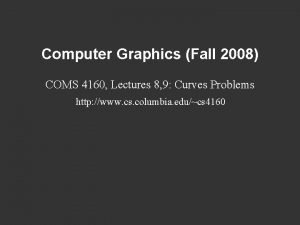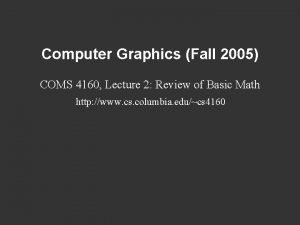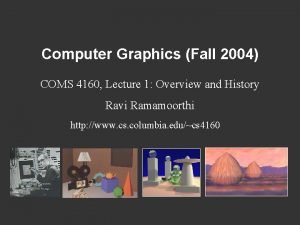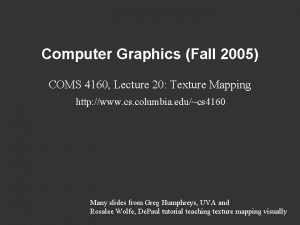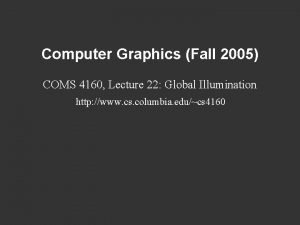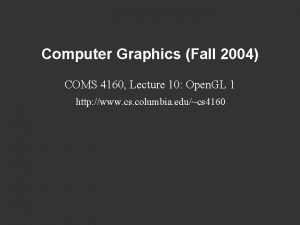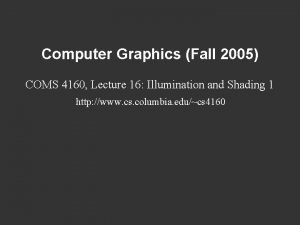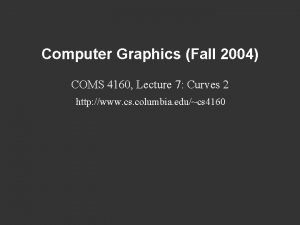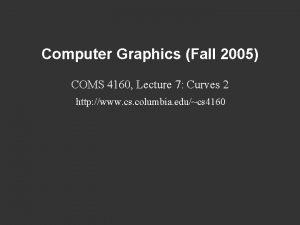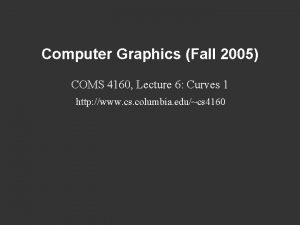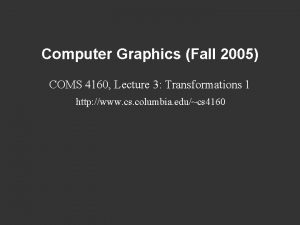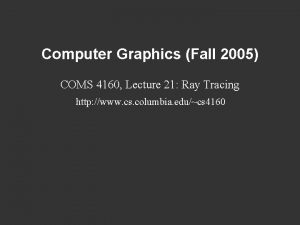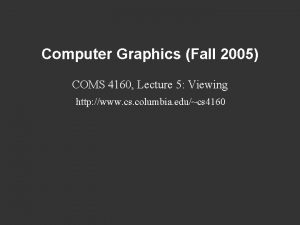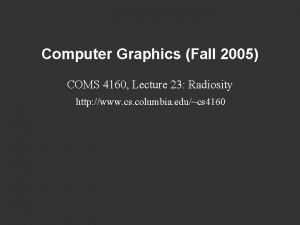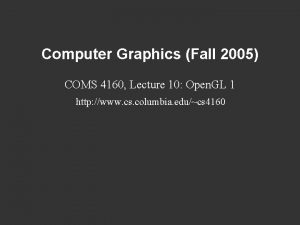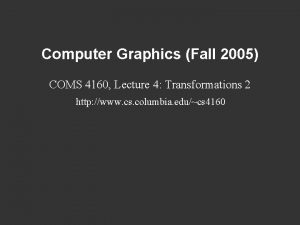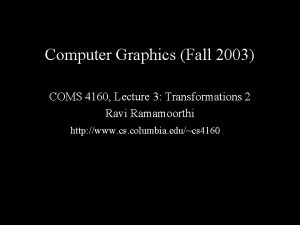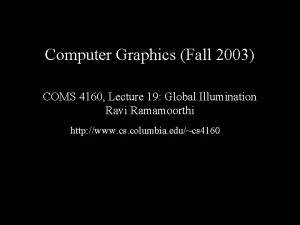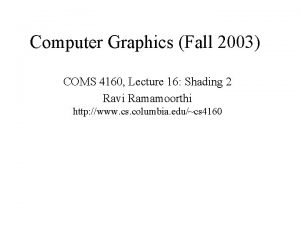Computer Graphics Fall 2008 COMS 4160 Lecture 19







![Building up the BRDF • Bi-Directional Reflectance Distribution Function [Nicodemus 77] • Function based Building up the BRDF • Bi-Directional Reflectance Distribution Function [Nicodemus 77] • Function based](https://slidetodoc.com/presentation_image/428a1a3af3957407369552390328f0b0/image-8.jpg)

























- Slides: 33

Computer Graphics (Fall 2008) COMS 4160, Lecture 19: Illumination and Shading 2 http: //www. cs. columbia. edu/~cs 4160

Radiance • Power per unit projected area perpendicular to the ray per unit solid angle in the direction of the ray • Symbol: L(x, ω) (W/m 2 sr) • Flux given by dΦ = L(x, ω) cos θ dω d. A

Radiance properties • Radiance is constant as it propagates along ray – Derived from conservation of flux – Fundamental in Light Transport.



Radiance properties • Sensor response proportional to radiance (constant of proportionality is throughput) – Far away surface: See more, but subtends smaller angle – Wall equally bright across viewing distances Consequences – Radiance associated with rays in a ray tracer – Other radiometric quants derived from radiance

Irradiance, Radiosity • Irradiance E is radiant power per unit area • Integrate incoming radiance over hemisphere – Projected solid angle (cos θ dω) – Uniform illumination: Irradiance = π [CW 24, 25] – Units: W/m 2 • Radiosity – Power per unit area leaving surface (like irradiance)
![Building up the BRDF BiDirectional Reflectance Distribution Function Nicodemus 77 Function based Building up the BRDF • Bi-Directional Reflectance Distribution Function [Nicodemus 77] • Function based](https://slidetodoc.com/presentation_image/428a1a3af3957407369552390328f0b0/image-8.jpg)
Building up the BRDF • Bi-Directional Reflectance Distribution Function [Nicodemus 77] • Function based on incident, view direction • Relates incoming light energy to outgoing light energy • We have already seen special cases: Lambertian, Phong • In this lecture, we study all this abstractly


BRDF • Reflected Radiance proportional to Irradiance • Constant proportionality: BRDF [CW pp 28, 29] – Ratio of outgoing light (radiance) to incoming light (irradiance) – Bidirectional Reflection Distribution Function – (4 Vars) units 1/sr



Isotropic vs Anisotropic § Isotropic: Most materials (you can rotate about normal without changing reflections) § Anisotropic: brushed metal etc. preferred tangential direction Isotropic Anisotropic

Radiometry § Physical measurement of electromagnetic energy § We consider light field § Radiance, Irradiance § Reflection functions: Bi-Directional Reflectance Distribution Function or BRDF § Reflection Equation § Simple BRDF models

Reflection Equation Reflected Radiance (Output Image) Incident BRDF radiance (from light source) Cosine of Incident angle

Reflection Equation Sum over all light sources Reflected Radiance (Output Image) Incident BRDF radiance (from light source) Cosine of Incident angle

Reflection Equation Replace sum with integral Reflected Radiance (Output Image) Incident BRDF radiance (from light source) Cosine of Incident angle

Radiometry § Physical measurement of electromagnetic energy § We consider light field § Radiance, Irradiance § Reflection functions: Bi-Directional Reflectance Distribution Function or BRDF § Reflection Equation § Simple BRDF models

Brdf Viewer plots Diffuse Torrance-Sparrow Anisotropic bv written by Szymon Rusinkiewicz

Demo





Analytical BRDF: TS example § One famous analytically derived BRDF is the Torrance-Sparrow model. § T-S is used to model specular surface, like the Phong model. § more accurate than Phong § has more parameters that can be set to match different materials § derived based on assumptions of underlying geometry. (instead of ‘because it works well’)

Torrance-Sparrow § Assume the surface is made up grooves at the microscopic level. § Assume the faces of these grooves (called microfacets) are perfect reflectors. § Take into account 3 phenomena Shadowing Masking Interreflection

Torrance-Sparrow Result Fresnel term: allows for wavelength dependency How much of the macroscopic surface is visible to the light source Geometric Attenuation: reduces the output based on the amount of shadowing or masking that occurs. How much of the macroscopic surface is visible to the viewer Distribution: distribution function determines what percentage of microfacets are oriented to reflect in the viewer direction.

Other BRDF models § Empirical: Measure and build a 4 D table § Anisotropic models for hair, brushed steel § Cartoon shaders, funky BRDFs § Capturing spatial variation § Very active area of research

Complex Lighting § So far we’ve looked at simple, discrete light sources. § Real environments contribute many colors of light from many directions. § The complex lighting of a scene can be captured in an Environment map. § Just paint the environment on a sphere.

Environment Maps § Instead of determining the lighting direction by knowing what lights exist, determine what light exists by knowing the lighting direction. Blinn and Newell 1976, Miller and Hoffman, 1984 Later, Greene 86, Cabral et al. 87

Demo

Conclusion § All this (Open. GL, physically based) are local illumination and shading models § Good lighting, BRDFs produce convincing results § Matrix movies, modern realistic computer graphics § Do not consider global effects like shadows, interreflections (from one surface on another) § Subject of next unit (global illumination)

What’s Next § Have finished basic material for the class § Texture mapping lecture later today § Review of illumination and Shading § Remaining topics are global illumination (written assignment 2): Lectures on rendering eq, radiosity § Historical movie: Story of Computer Graphics § Likely to finish these by Dec 1: No class Dec 8, § Work instead on HW 4, written assignments § Dec 10? will be demo session for HW 4
 Graphics monitors and workstations and input devices
Graphics monitors and workstations and input devices Dot matrix display ppt
Dot matrix display ppt 2008 2008
2008 2008 01:640:244 lecture notes - lecture 15: plat, idah, farad
01:640:244 lecture notes - lecture 15: plat, idah, farad Coms 6998
Coms 6998 Sambit sahu columbia
Sambit sahu columbia Coms 4705
Coms 4705 Halfcoms
Halfcoms Coms
Coms Coms 6998
Coms 6998 Abhinav kamra
Abhinav kamra Coms 4115
Coms 4115 Coms 3261
Coms 3261 Coms project
Coms project Coms 4118
Coms 4118 Coms 6998
Coms 6998 Coms 6998
Coms 6998 Computer security 161 cryptocurrency lecture
Computer security 161 cryptocurrency lecture Computer-aided drug design lecture notes
Computer-aided drug design lecture notes Architecture lecture notes
Architecture lecture notes Computer architecture lecture
Computer architecture lecture Crt in computer graphics
Crt in computer graphics What is viewing in computer graphics
What is viewing in computer graphics Display devices in computer graphics
Display devices in computer graphics In two dimensional viewing we have?
In two dimensional viewing we have? Shear transformation in computer graphics
Shear transformation in computer graphics Glsl asin
Glsl asin Define scan conversion in computer graphics
Define scan conversion in computer graphics Equation of motion of a rotating rigid body
Equation of motion of a rotating rigid body Two region filling algorithms are
Two region filling algorithms are Dda algorithm advantages and disadvantages
Dda algorithm advantages and disadvantages Polygon filling algorithm in computer graphics
Polygon filling algorithm in computer graphics Random scan display is also called as
Random scan display is also called as Computer graphics
Computer graphics




